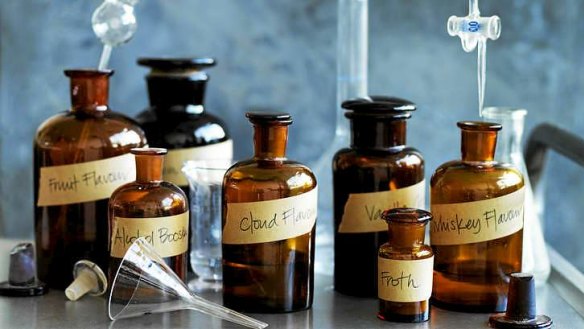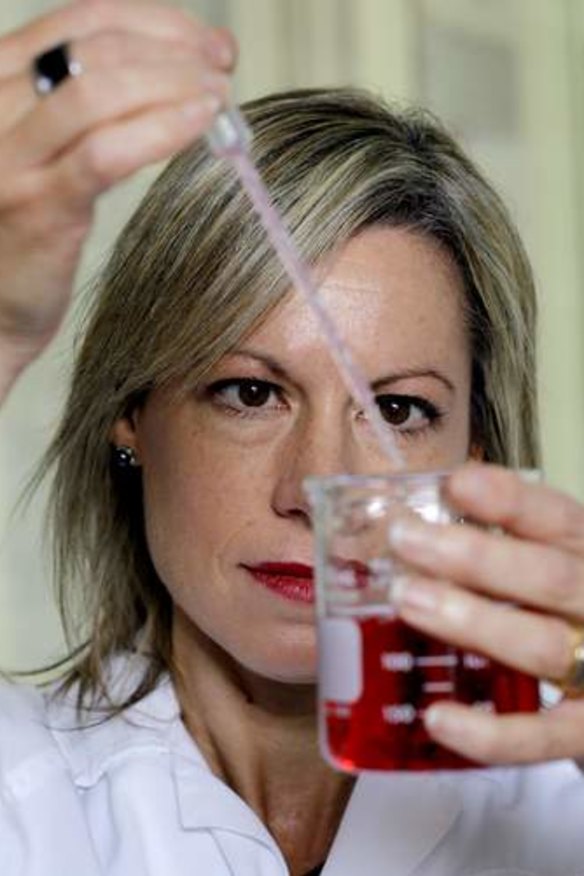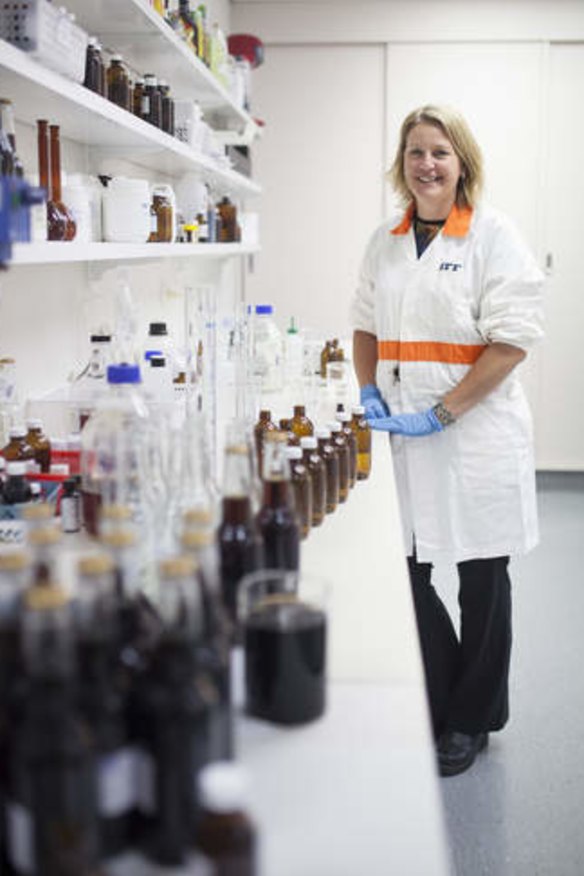The flavour-makers
Inside the secretive world of the people who put the flavour in our food.

Nothing is as it seems inside the secretive world of flavour-making. It's a multibillion-dollar industry that has a hand in almost everything we eat, from packet mixes to bottled sauces, spreads, sweets and drinks. An estimated 90 per cent of supermarket products start life in a laboratory, where scientists in white coats use complex chemical formulas to recreate the flavours of oranges, raspberries, ''barbecue'' or, bizarrely, clouds, while going nowhere near the real thing.
A glimpse behind the veil of the flavour-making industry is rare. Few are allowed inside the fluorescent-lit labs, where all things natural and unnatural are conceived, measured and mixed for our tasting pleasure.
In one such laboratory, on Sydney's northern beaches, senior flavourist Julie Mitchell opens a little bottle labelled ''energy flavour''. Hundreds of similar sepia-coloured containers line the white shelves, containing flavours for cherries, peach, lemon and cola. Curiouser still are concoctions labelled ''fruit flavour'', ''vanilla custard flavour'', ''whiskey flavour'' and ''alcohol booster flavour''.
Mitchell waves the bottle of energy flavour under my nose; it has the sickly sweet, medicine-like odour of Red Bull. "We can mimic that. We can mimic anything," she says.
Flavour-makers not only mimic nature, but "make it taste better", Mitchell says.
"If you take an apple, for example, there might be something in there that most people don't like. You can't take it out of the apple, whereas we can," she says. "I can create anything and call it a strapple instead of an apple. I could do that, it's all possible."

Mitchell works for German company Symrise, one of the world's top "fragrance and flavour houses", with prestige clients such as PepsiCo, alcohol company Diageo and Unilever, whose brands include Streets ice-cream and Lipton. She is lean with straight blonde hair and happens to be the first "super taster" (someone with proven enhanced powers of taste and smell) I have met.
She likes to point out products on the supermarket shelves, saying, "that's mine". "Inevitably, every packet of food you get from the supermarket will have flavour in it," she says. "We concentrate nature, basically, and offer it in a little bottle to make anything taste like what it is supposed to taste like. Strawberry, chocolate, caramel or whatever."
Before we meet, I flick through the Symrise employee magazine with articles on onion juice, the "language of colours" and a "sweets freak show".

Flavour-making has its own strange vocabulary of words such as "vanillac", "caramellic" and "cumeritic".
Flavourists need heightened sensory powers and an almost poetic sensibility. Mitchell studied food science before switching to flavour creation. "It's kind of like being an artist painting a picture - you feel like you're creating something that's unique, that's yours," she says.
"I am sure all flavourists have their little aroma chemicals or essential oils that tend to be their signature. I love adding a touch of saffron to things."
On the way to her lab, we pass a red-lit room filled with "sensory booths", where sample tasters trial new flavours. The red lights are supposed to neutralise the impact of colour on how we taste. "In the past we have got red cups and put apple flavour in them and asked people to tell us what the flavour was, and they said it was raspberry yoghurt. Then we did the same with green cups and they said it was apple yoghurt," Mitchell says.
Tasting is a complex confluence of senses - of taste, sight, hearing, touch and, predominantly, smell. Tests have shown that even the texture of a sauce changes the perception of its flavour.
Emotion, too, plays a role. Mitchell says she thinks of her father whenever she smells someone wearing Brut.
She shows me the small kitchen where her flavours are mixed into foods. The fridge is filled with unlabelled bottles of alcohol-flavoured drinks. On the bench are 15 variations of a caramel-flavoured cookie. Mitchell invites me to try a few. "They all taste like caramel," I say.
In an adjoining room, hundreds of flavours are stored in floor-to-ceiling filing cabinets. I smell something vaguely like disinfectant. It's like peeping under the magician's hat and finding a robot rabbit underneath.
Flavour companies zealously protect their clients' secrets. I am not allowed to reveal the names of any products for which Mitchell has created flavours. Symrise is reluctant even to allow Mitchell to be photographed, preferring to keep a veil between a flavourist in a laboratory and the food we eat.
"While everybody likes to enjoy a Magnum ice-cream, no one likes to be reminded that there are flavours in what they eat," says Symrise marketing manager Gaelle Dami.
The taste of love
In a second laboratory in the suburbs is a black box labelled "the taste of love", containing strawberry flavours in little dark bottles. There are about 300 more versions of strawberry - from creamy or fruity, through to jammy, wild and "green" - in the International Flavors & Fragrances labs.
Inside the US company's Melbourne office, in an arid industrial stretch in the city's south-east, creations and applications manager Sandra Grogan is creating a new strawberry-flavoured yoghurt. She mixes minute quantities of liquid from the bottles into a glass beaker. "I want to take the flavour of strawberry jam on toast and put it in a yoghurt," she says, stirring her concoction.
Decoding the secrets of strawberries starts with machines that extract scent molecules from foods, creating a detailed molecular map of flavours. The "taste of love" is actually a complex chemical formula of different flavour notes, from "leaf green" (or cis-3-hexenol) to "fruity green" (cis-3-hexenyl acetate).
IFF is the world's largest flavour company, with revenues hitting $US3 billion in 2013. Walking around its laboratories is like touring Willy Wonka's chocolate factory. I pass a man wearing a hairnet who is shovelling handfuls of chips into bags marked "steak and onion". There is a breathalyser in the beverages room for people testing new alcopop flavours.
In another room, called the Flavour Bank, rows of bottles on the shelves contain flavours for cashews, eggnog, "froth", "cloud" or "silken cotton". What does silken cotton taste like, I ask Grogan. "It is very light and airy, slightly caramelised," she says.
"It might remind you a little bit of fairy floss … It's all around marketing and how you spin a story a lot of the time."
Putting flavours into foods improves reliability of taste and extends their shelf life. But few consumers like to think of their food being created inside a laboratory. Food companies prefer to talk about adding "natural flavours", which must be derived from natural sources - such as spices, vegetables, fruit or meat. "Consumers are looking for that natural experience rather than the synthetic profile," Grogan says.
Natural versus artificial
A natural flavour is not necessarily healthier than an artificial one. The distinction between the two can be somewhat arbitrary and absurd, notes journalist Eric Schlosser in his book Fast Food Nation.
"Natural and artificial flavours are now manufactured at the same chemical plants, places that few people would associate with Mother Nature,'' says Schlosser. ''Calling any of these flavours 'natural' requires a flexible attitude toward the English language and a fair amount of irony."
Grogan doesn't like using the word "chemicals" to describe the compounds inside the little bottles she uses to create flavours. "Chemicals just sounds harsh and scary to people. Whereas if we talk about 'raw materials', it gives a warmer approach to a product."
The industry is constantly refining its processes. One of the biggest challenges flavour-making companies face today is creating indulgent flavours for a health-conscious market, she says. I ask her to nominate the Holy Grail of flavours and she says Coca-Cola. "Everyone wants to match Coke. If you lined up all the cola flavours, you probably wouldn't pick Coke as the best, but it is the brand that sells that cola flavour."
Most of the time, clients want her to tweak popular flavours so they can use them in their own products, rather than create new ones from scratch. "We are often trying to mimic natural food products or flavours, like apple juice or strawberry," she says.
"Other times we are trying to enhance or mask flavour notes in a product. If you think about orange juice, when you process the juice you lose a lot of the flavour profile through the heating process. So we add raw materials to bring those flavours back, to get more aroma and more taste out of the product."
She takes a little bottle of liquid from the shelf and sticks it under my nose. I close my eyes and smell the unmistakable odour of Neapolitan ice-cream. My mind is whisked back to childhood summers and sticky hands and the sea. When I open my eyes, I am still in a laboratory in the suburbs. Grogan smiles. "There are no limits to the flavours we can create," she says.
"We can mix roast beef and candy floss together. The world is endless. If someone wants something weird and wacky, we will make it weird and wacky."
The taste test fail on banana lollies
Lolly bananas taste nothing like the real thing. The lurid little sweet treats are practically an artefact in flavour-making terms, created by guesswork when little was known of the molecular make-up of flavours.
Flavourists can now decode in detail the chemicals used by nature to flavour food. But don't expect to see an actual banana-flavoured lolly to replace the classic confectionery on the Australian market any time soon. "People are used to it. They still expect lolly bananas to be like that," says flavourist Julie Mitchell.
"I don't want to make it sound like we're boring but we kind of are. If you look at what we get briefed on, it is always strawberry, chocolate, vanilla, mango, caramel. I can come up with all these wonderful flavours [for clients] - I have got this hibiscus and passionfruit thing - and they say, 'Love it but we're never going to buy it'."
Tastes differ depending on where you are in the world. Flavourist John Wright, in his book Flavour Creation, says the British enjoy the flavour profile of roast beef, while Americans prefer a grilled beef flavour.
Strawberry flavour is more complex still, Wright says. "In the US, strawberry is generally sweet and slightly jammy. Within Europe, the French taste is for a pronounced jasmine note and the Spanish taste is for strawberry jam."
The Australian palate is particularly attuned to Asian flavours, says Thomas Kressin, culinary development manager at Flavour Makers food company, in Melbourne. He reckons South American flavours - such as mole sauces - will grow in popularity with this year's soccer World Cup in Brazil.
Flavour Makers creates flavours for food company clients and for its own range of food products. Any flavour can be created for the supermarket shelf. But there are limits to what people will buy. Even a fantastic flavour such as "barbecue", with no ready relation in the natural world, is bounded by our boring tastes. "We have to stay within a set of parameters of what people say is barbecue," Kressin says.
Restaurant reviews, news and the hottest openings served to your inbox.
Sign up